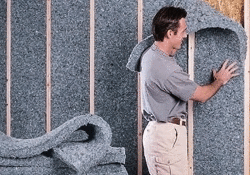INDUSTRIAL SOUNDPROOFING

Industrial Acoustics Industrial acoustics deals with the subject of noise generation and control in the industry. Noise beyond some level is unbearable and persons in working in industries and other workplaces who are continuously exposed to such noises are in danger of suffering loss of hearing permanently. Therefore it is very important to take measures to reduce noise levels in such cases. Apart from the danger of hearing loss, noise can disrupt sleep, affect speech, and cause other discomforts. Also, noise and vibration above certain levels can result in structural failures and also reduced life span of machines and other industrial equipment. For example, vibration in control valves cause flow instability causing defective feedback signals and result in undesirable oscillations. The main sources of high noises in industry are aircrafts, surface transport vehicles, construction activity, and industrial machinery. We may call them sources of noise pollution. Principles of Noise Control Industrial acoustics addresses the noise control problem in three elements: They are the source of sound, the path travelled by sound, and the receiver. The source of noise or sound can be a vibrating panel or other part in a machine, a jet engine in an aircraft etc. The path of travel of noise is usually the air between the source and the receiver, that is, the human ear. This may be direct between the machine and the operator, or indirect as reflected sound from a wall. Acoustic engineer has to identify the source and path before he can find a solution. The receiver of sound or noise is usually the human ear, though a sensitive equipment could also be the receiver. In either case excessive sound could be harmful. In the case of a sensitive equipment it may lead to impaired function. Noise Control at the Source It is best to eliminate noise at the source itself. The component responsible for the noise may be modified. The noise could also may be due to poor maintenance. Proper preventive maintenance is one of the solutions for problems of Industrial acoustics. For example replacement of a defective bearing. Often a panel may be vibrating excessively and producing annoying noise. Applying a damping material to the panel can reduce the noise. Path Travelled by Sound For noise sources placed outside the solution could be moving the source further away from the receiver. For noise sources placed inside the building or outside, building a barrier like a wall can reduce noise. This is done for blocking noise vehicles on freeways passing near residences, hospitals etc. For noise sources placed inside with closer proximity to receiver, using sound absorbing acoustic materials for walls, ceilings and floor will control noise levels. For noise from engines, fit mufflers and silencers to exhaust pipes. Noise Control at the Receiver Use ear plugs or other hearing protectors whenever possible. Avoid long periods of exposure to high noises. Educate the receiver about the safe use of ear plugs. There is increasing awareness about noise problem in industry as well as in homes. A number of measures are initiated by authorities to contain this problem. Industrial acoustics is gaining increased attention.